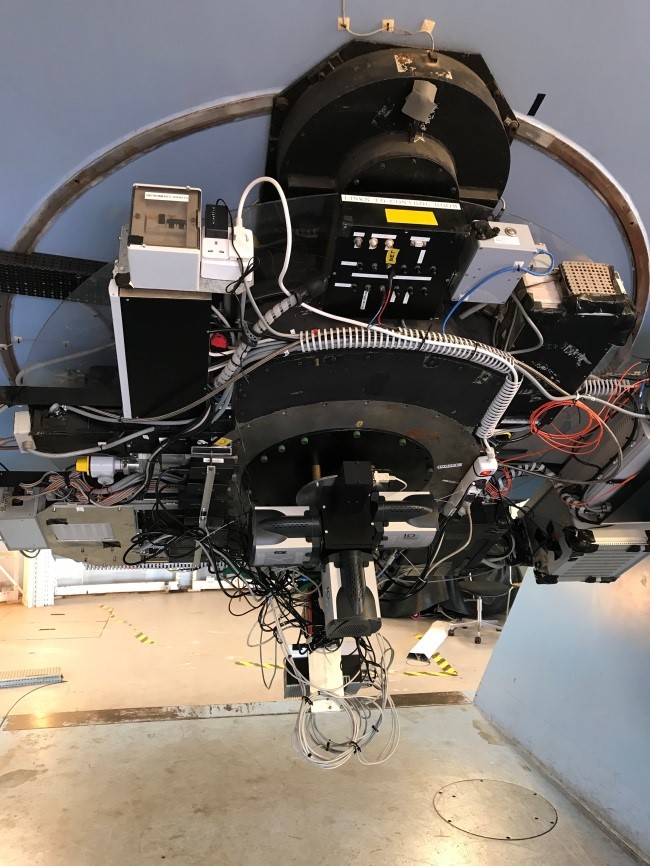Astro-polarimetry is an important method in astronomical observation, aimed at detecting and measuring polarisation of light emitted, reflected, or scattered by astronomical objects such as asteroids, planets, nebulae, stars and exoplanets. The astro-polamiter built with the lead of a research group from the University of Turku made its first observations in July 2019 at the Nordic Optical Telescope on the Canary Islands. In October 2019, the University of Turku becomes the joint owner of the Telescope.
In space, the degree and direction of polarisation depends on spatial distribution and density of matter that reflects or scatters light, the properties of light-scattering particles, and physical conditions in stellar and planetary atmospheres. An astro-polarimeter is an instrument that allows astronomers to obtain this information by studying the polarisation of various celestial objects.
– By studying the polarisation of light, we can obtain information on the structure and composition of stellar and planetary atmospheres as well as on dust and gas disks surrounding young stars, out of which new planets will form. When observing high-density objects, such as white dwarfs, neutron stars and black holes, we can study how matter behaves in extremely strong gravitational and magnetic fields, says Senior Researcher, Docent Andrei Berdyugin from the University of Turku.
Tuorla Observatory at the Department of Physics and Astronomy of the University of Turku is known in the astronomical community for building high-quality, high-precision instruments for measuring polarisation in the optical wavelengths. The new Dipol-UF astro-polarimeter was designed, built and commissioned with the lead of the research group at the University of Turku and in co-operation with the Leibniz Institute for Solar Physics in Germany. In addition to Berdyugin, the research group at the University of Turku includes Docent Emeritus Vilppu Piirola and Doctoral Candidate Ilia Kosenkov.
– The first observations with the instrument were made in July 2019 at the Nordic Optical Telescope at La Palma. During two nights, Dipol-UF measured polarisation from a number of stars with an accuracy better than one per hundred thousand in the blue, green and red parts of spectrum. High accuracy is needed so we can differentiate the weaker polarisation signal of an exoplanet from that of the star it’s orbiting, for instance. Because of the instrument’s high sensitivity, we can also study the interstellar magnetic field in proximity of the Sun, says Berdyugin.
The instrument is equipped with three high-speed ANDOR EM CCD cameras which are capable of recording images of the sky with the impressive rate of 56 frames per second. The instrument employs three industrial grade mini-PCs and special optical layout to record images in polarised light simultaneously in three colours.
– The process of observations with Dipol-UF is highly automated and all observations can in principle also be done remotely from a few thousand kilometres away, describes Berdyugin.
University of Turku Becomes Joint Owner of Nordic Optical Telescope
In October 2019, the Nordic Optical Telescope is transferred to the ownership of the University of Turku and Aarhus University in Denmark. The University of Turku maintains the telescope and its facilities whereas Aarhus University is responsible for the personnel.
The observatory situated at the height of 2.4 kilometres above sea level at La Palma is one of the best places in the world for astronomical observation. The great location, high-quality optics, and extensive array of instruments make the Nordic Optical Telescope a highly efficient observatory.
The Nordic Optical Telescope has a key role in Finnish astronomy offering unique opportunities especially for long-term projects studying active galaxies, supernovae, binary stars, magnetically active stars, and objects in the solar system.

Dipol-UF mounted at the bottom of the 2.56 m Nordic Optical Telescope.
More images
Normal image of the area of stellar sky: https://apps.utu.fi/media/kuvat/tahtitaivas.JPG
The same area of sky as seen by the polarimeter: https://apps.utu.fi/media/kuvat/tahtitaivas_polarimetri.JPG (A special optical element, a plane-parallel calcite plate, inserted into the optical path splits each stellar image into two orthogonally polarised ones. By measuring the relative intensities of these images, researchers can measure the polarisation of stellar light.)
Header image: Arthur Radko / Nordic Optical Telescope Scientific Association
More information
Andrei Berdyugin, tel. +358 40 750 2316, andber@utu.fi
Vilppu Piirola, tel. +358 40 540 2701, piirola@utu.fi
